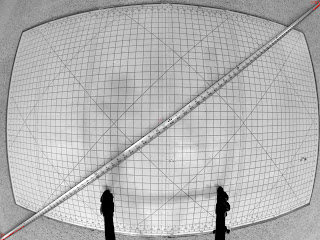Initial Evaluation of SpaceX / Tesla Orbital Stability
Executive summary: its orbit is not very stable.
 |
| Photo courtesy of SpaceX |
On February 6, 2018, SpaceX performed its test launch of its new Falcon Heavy rocket. It was a very successful launch. As most people know, the payload was Elon Musk's 2008 Tesla Roadster. After orbiting the Earth for a few hours, the upper stage lit up again and sent the Tesla on a Solar orbit:
Musk has famously tweeted that the Tesla will be orbiting for "a billion years." This is extremely unlikely. In fact, it will likely crash into the Sun, or a planet (most likely Earth but perhaps Venus), or be ejected from the Solar System.
To try to characterize this, I went to NASA's JPL Horizons web page to get current Cartesian elements for the Tesla (these are vectors of position and velocity). These are the elements as of today, February 10, 2018:
2458159.500000000 = A.D. 2018-Feb-10 00:00:00.0000 TDBI also got Cartesian elements for the Sun and major planets (including the Moon but excluding Pluto). You can see this data in this PDF file, along with inputs for the orbital simulation software I use.
X =-7.690802173107607E-01 Y = 6.236475652855626E-01 Z =-1.393643118679943E-03
VX=-1.252512462814835E-02 VY=-1.488196764720304E-02 VZ=-3.764542211631047E-04
The orbital simulation software is Swifter, which is written in Fortran 90 and provides state-of-the-art orbital integration. There is a corresponding package, SwiftVis, which allows for visualization of the produced data files.
I started by simulating 1000 years using the fourth-order Symplectic algorithm ("TU4"). I then looked at how the eccentricity and semimajor axis evolved. If the orbit were stable, these values should not change much. But they do change, a lot:
Notice the spikes, which indicate perturbations by some body. But notice especially the jump just before 600 years in the future. Something happens. And that "something" looks to be a close Earth encounter - closer than 98,000 KM - in the year 2585:
The Earth's gravity will significantly perturb the Tesla's orbit. And, unfortunately for the stability of the orbit, it perturbs it in a way that leaves its orbit crossing the Earth's orbit not very far inside - this shows perihelion distance. Notice the jump just before 600 years:
This means a lot more future potential encounters with Earth. I'm running a much longer simulation now (target: 1 million years) to see how the orbit lasts. But the existence of such a close encounter so soon does not bode well for the Tesla's orbital stability.
Edit: Here are the charts for 25,000 years of simulation. First, the eccentricity, which is kind of stable, but looks like it is starting to wander again:
Finally, the semimajor axis, which was creeping up (stretched by planetary perturbations) but looks like it is dipping back down again:








Comments